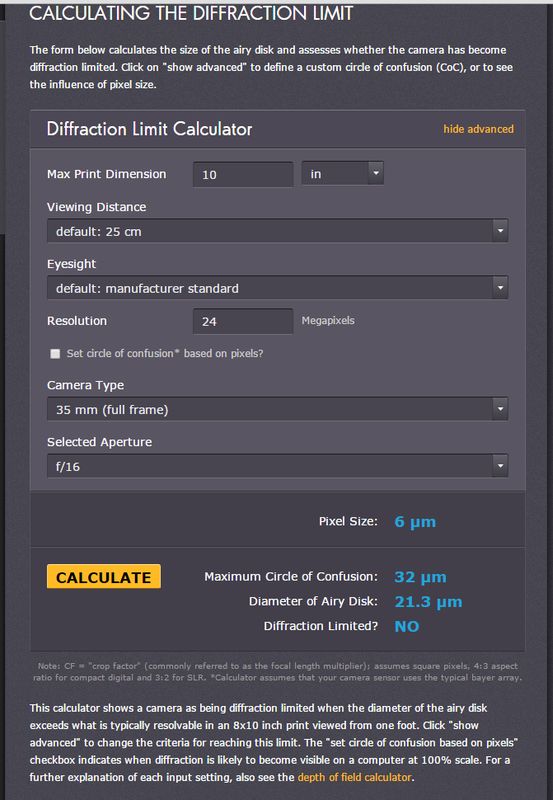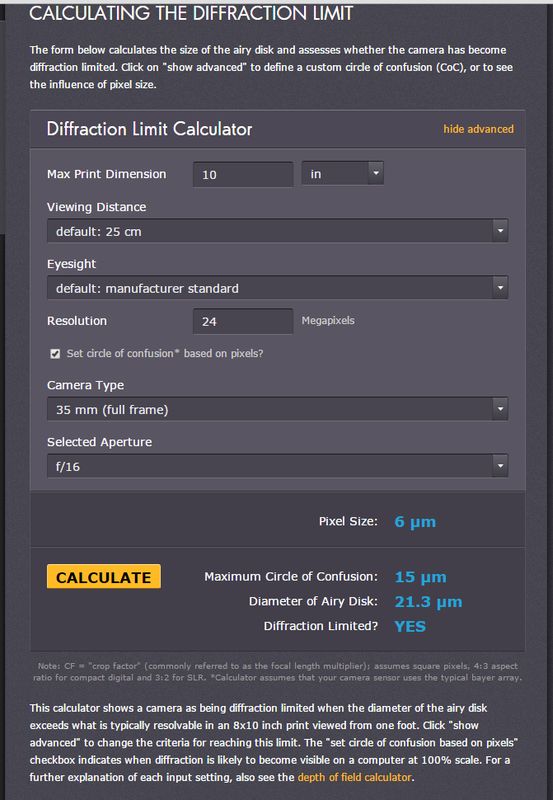Diffraction Limit Calculator at Cambridge in Colour
Feb 10, 2016 10:06:32 #
Like depth of field, diffraction does not happen suddenly. We calculate that it happens once the diameter of the airy disk exceeds the diameter of the circle of confusion. The difference between being just under or just over is not something you will be able to see. These two diameters may seem arbitrary but they are based on sound principles. Both terms are described in depth on their site and elsewhere on the Internet and they are easy to look up.
Open the Diffraction Limit Calculator and click on show advanced to see the relationships among the six parameters that affect diffraction:
Max Print Dimension Diffraction is more apparent in a larger print if you keep the viewing distance the same.
Viewing distance Diffraction is less apparent if you view the same print from further away.
Eyesight You are more likely to see diffraction if your eyesight is above average.
Digital resolution MP You are more likely to see diffraction if you view an image on the screen at 100%.
Camera Type (sensor or film format) Diffraction is worse for smaller sensors and film sizes and almost invisible in medium or large format film.
Aperture Diffraction is more likely to be seen at smaller apertures if the image contains sharp edges and detail.
All of the calculations assume that you are not cropping the image.
If you keep the viewing distance proportional to the maximum print dimension appearance of diffraction is not affected. For example, a 20 inch print viewed from 50 cm has the same apparent diffraction as a 10 inch print viewed from 25 cm.
In Figure One you can see that a normal 8x10 inch print viewed from a normal viewing distance of 25 cm (about 10 inches) with normal eyesight, an aperture of f/16 does not produce visible diffraction. The 24x36 mm sensor image is magnified about 7x to a width of 10 inches (254 mm).
In Figure Two the same image is magnified to 100%. At 300 dpi makes a 20 inch wide print, a magnification of about 14x. In this case, f/16 is too small when viewed from 10 inches but not when viewed from 20 inches.
If the image is cropped by a factor of two (discarding 75% of the information) to a width of 10 inches, the magnification would still be 14x and the diffraction would also be visible at f/16. If you plan to crop the image because your focal length was too short you need to take this into account.
Open the Diffraction Limit Calculator and click on show advanced to see the relationships among the six parameters that affect diffraction:
Max Print Dimension Diffraction is more apparent in a larger print if you keep the viewing distance the same.
Viewing distance Diffraction is less apparent if you view the same print from further away.
Eyesight You are more likely to see diffraction if your eyesight is above average.
Digital resolution MP You are more likely to see diffraction if you view an image on the screen at 100%.
Camera Type (sensor or film format) Diffraction is worse for smaller sensors and film sizes and almost invisible in medium or large format film.
Aperture Diffraction is more likely to be seen at smaller apertures if the image contains sharp edges and detail.
All of the calculations assume that you are not cropping the image.
If you keep the viewing distance proportional to the maximum print dimension appearance of diffraction is not affected. For example, a 20 inch print viewed from 50 cm has the same apparent diffraction as a 10 inch print viewed from 25 cm.
In Figure One you can see that a normal 8x10 inch print viewed from a normal viewing distance of 25 cm (about 10 inches) with normal eyesight, an aperture of f/16 does not produce visible diffraction. The 24x36 mm sensor image is magnified about 7x to a width of 10 inches (254 mm).
In Figure Two the same image is magnified to 100%. At 300 dpi makes a 20 inch wide print, a magnification of about 14x. In this case, f/16 is too small when viewed from 10 inches but not when viewed from 20 inches.
If the image is cropped by a factor of two (discarding 75% of the information) to a width of 10 inches, the magnification would still be 14x and the diffraction would also be visible at f/16. If you plan to crop the image because your focal length was too short you need to take this into account.
Feb 11, 2016 04:30:35 #
selmslie wrote:
Like depth of field, diffraction does not happen s... (show quote)
:thumbup: :thumbup: :thumbup:
Feb 11, 2016 05:03:29 #
Leitz
Loc: Solms
selmslie wrote:
Like depth of field, diffraction does not happen suddenly. We calculate that it happens once the diameter of the airy disk exceeds the diameter of the circle of confusion. The difference between being just under or just over is not something you will be able to see. These two diameters may seem arbitrary but they are based on sound principles. Both terms are described in depth on their site and elsewhere on the Internet and they are easy to look up.
This appears to assume that all lenses perform the same at any given aperture. But do they?
Feb 11, 2016 07:18:21 #
Leitz wrote:
This appears to assume that all lenses perform the same at any given aperture. But do they?
No, this assumes that the lens is otherwise perfect.
We know that other lens shortcomings contribute to softness in the image but that is in addition to diffraction.
Also note that diffraction is independent of focal length, which is explained below the calculator.
Feb 11, 2016 08:15:49 #
Leitz
Loc: Solms
selmslie wrote:
We know that other lens shortcomings contribute to softness in the image but that is in addition to diffraction.
Right. This is why diffraction is less of an issue with better lenses.
selmslie wrote:
Also note that diffraction is independent of focal length, which is explained below the calculator.
Right again. :)
Feb 11, 2016 09:00:55 #
Leitz wrote:
This is why diffraction is less of an issue with better lenses.
Sharpness is less of an issue with better lenses.
Diffraction is independent of the quality of the lens. It's just that you can't isolate it from the other sources of degradation unless the lens is close to perfect.
The point I am trying to make is that for normal print sizes and normal viewing distances, you should not have to worry about diffraction with a full-frame sensor. The problem only shows up with smaller sensors, very large prints or images viewed from unreasonably close up and images that are highly cropped and magnified.
For 6x6 cm film diffraction only starts to become visible around f/45. The calculator does not go high enough to show the diffraction limit for 4x5 film but it is probably around f/90 (I am just guessing) and for 8x10 maybe around f/180. At least one photographer I know of who has used 16x20 film does not have a problem with diffraction at f/256.
Feb 11, 2016 09:11:10 #
Leitz
Loc: Solms
selmslie wrote:
The point I am trying to make is that for normal print sizes and normal viewing distances, you should not have to worry about diffraction with a full-frame sensor.
No doubt about that!
Feb 11, 2016 09:16:20 #
Leitz wrote:
No doubt about that!
A full frame image also does not exceed the diffraction limit for a normal print (not base on pixels) at f/22 but if you use a 1.5 crop factor lens it does.
If you compare a 36 MP full frame image at 100% with a 1.5 crop factor image (16 MP on the same camera), both versions show nearly the same diffraction limit - somewhere between f/8 and f/11.
If you want to reply, then register here. Registration is free and your account is created instantly, so you can post right away.



